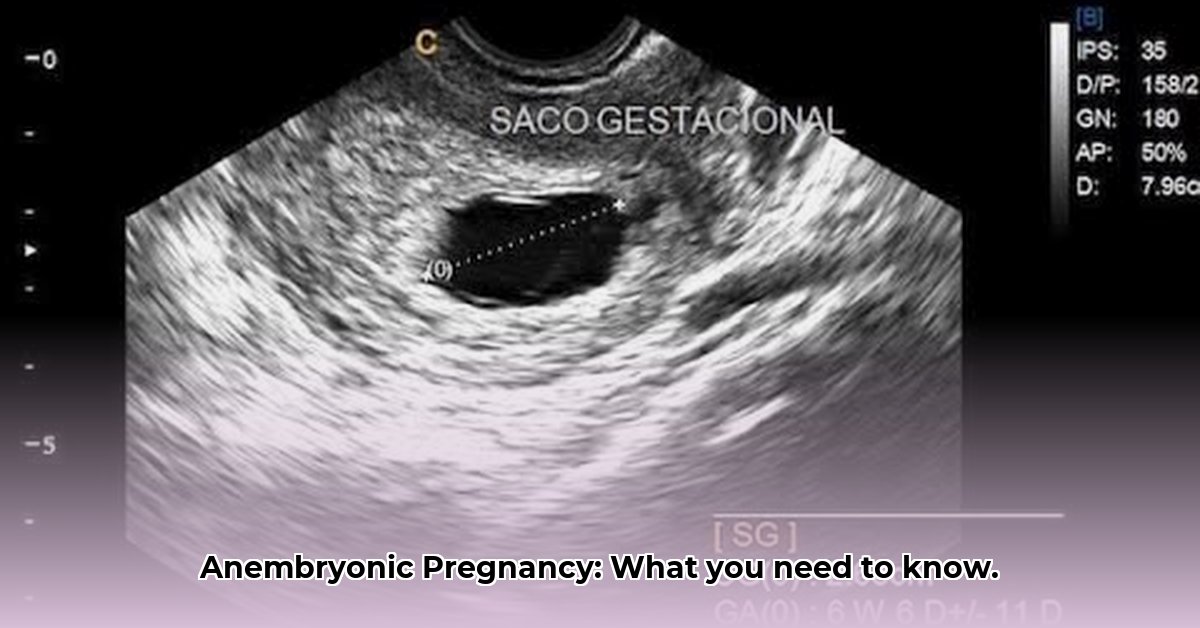Miscarriage is a painful experience, and understanding the reasons behind it can significantly aid in the healing process and future planning. This guide aims to explain anembryonic pregnancy, also known as a blighted ovum, which is a type of miscarriage where the pregnancy sac develops, but an embryo doesn’t. We will discuss the causes, risks, treatment options, coping mechanisms, and ways to support your emotional well-being. Our goal is to provide you with the necessary information and support to navigate this challenging experience, from immediate steps to understanding the chances of a healthy future pregnancy. For information on financial assistance, check out coverage options.
Embarazo Anembrionario: Navigating a Difficult Diagnosis
Losing a pregnancy is an incredibly difficult experience, and understanding why it happened can be equally challenging. Anembryonic pregnancy, also known as a blighted ovum or empty gestational sac, represents one such experience. Let’s discuss what this means and the best ways to navigate this challenging time with emotional support and clear medical information.
What is an Anembryonic Pregnancy?
Imagine the initial joy of a positive pregnancy test, followed by the crushing disappointment of learning that the fertilized egg implanted in your uterus without developing into an embryo. That’s anembryonic pregnancy. You’ll have a gestational sac – a fluid-filled pouch that usually holds a developing baby – but it is empty. It’s a devastating early pregnancy loss that affects many women. While a pregnancy test may be positive due to the presence of pregnancy hormones, an ultrasound reveals the absence of an embryo. This can be a confusing time where understanding your options is key. Anembryonic pregnancy typically occurs very early in gestation, often before a woman even realizes she’s pregnant.
Understanding the Diagnosis: What to Expect
The primary method for diagnosing anembryonic pregnancy involves an ultrasound, a non-invasive imaging technique. A transvaginal ultrasound, where a probe is inserted into the vagina, provides a clearer image in early pregnancy. The ultrasound technician will look for the presence of a gestational sac and, within it, a yolk sac and an embryo. In an anembryonic pregnancy, only the gestational sac will be visible, confirming the absence of an embryo. Blood tests measuring hCG (human chorionic gonadotropin) – the pregnancy hormone – might initially indicate pregnancy, but levels won’t rise appropriately as in a healthy pregnancy; they may plateau or even decline. Serial hCG testing, performed every few days, can help confirm the diagnosis. Discuss test results with your healthcare provider for clarity. Open communication with your doctor is vital during this emotional process. The diagnosis is typically confirmed if a gestational sac of a certain size (usually greater than 25mm) is seen without a visible embryo.
Why Does This Happen? Unraveling the Causes
A common reason for an anembryonic pregnancy is a chromosomal abnormality in the egg or sperm. These genetic instructions serve as blueprints for a baby, and any errors render the embryo unable to develop properly. It’s like trying to build a house without a solid foundation. These abnormalities can occur randomly during fertilization and are not typically inherited. In many instances (around 80%), a blighted ovum is linked to chromosomal abnormalities in the fertilized ovum. While other factors may play a smaller role, chromosomal abnormalities are the primary cause. These can include issues with sperm or egg quality, or problems during cell division after fertilization. Genetic testing of the products of conception after miscarriage can sometimes help determine if a chromosomal abnormality was present. However, a specific cause isn’t always identifiable. Did you know that chromosomal abnormalities are the leading cause in most cases of anembryonic pregnancy? Maternal age can also increase the risk of chromosomal abnormalities.
Treatment Paths: Options and Decisions
Dealing with an anembryonic pregnancy means making difficult treatment choices. Main options include:
- Expectant Management: Letting your body miscarry naturally, though the length and intensity of this process varies. This involves waiting for the body to recognize the non-viable pregnancy and expel the gestational sac. This process can take several days or weeks and may involve cramping and bleeding similar to a heavy period.
- Medical Management (Medication Abortion): Taking medication, such as misoprostol, to induce a miscarriage, often more comfortable than waiting for a natural miscarriage. The medication helps to soften the cervix and contract the uterus, leading to the expulsion of the gestational sac. This option typically involves less bleeding than expectant management and can be completed at home.
- Surgical Management (D&C): A surgical procedure, also known as dilation and curettage, where the gestational sac is removed, usually performed quickly under anesthesia. The cervix is dilated, and the uterine lining is gently scraped to remove the pregnancy tissue. This is often the quickest option and can provide closure for some women.
Your doctor will discuss the pros and cons of each option based on your situation, preferences, and medical history. Factors like the gestational age, your overall health, and any previous pregnancy losses will influence the recommendation. This is a personal decision with no right or wrong answer. Some women prefer to let nature take its course, while others prefer a more controlled and predictable process.
Healing and Moving Forward: Emotional and Physical Considerations
Experiencing an anembryonic pregnancy is emotionally challenging. Allow yourself time to grieve this loss. Feeling sad, confused, or angry is normal. There’s no set timeline for healing. Lean on your support system – partner, family, friends, or a therapist. Joining a support group connects you with others who understand your experience. Look for online communities or local support groups specifically for women who have experienced early pregnancy loss. Remember, you’re not alone, healing is possible. Physically, your body will need time to recover. Expect some bleeding and cramping, regardless of the treatment method chosen. Follow your doctor’s advice regarding pain management and activity restrictions. Reach out for medical support if you experience heavy bleeding, fever, or signs of infection.
Future Pregnancies: Recurrence and Planning
While the risk of another anembryonic pregnancy is generally low, discuss future pregnancy plans with your health professional. Most women who experience an anembryonic pregnancy go on to have healthy pregnancies in the future. However, it’s natural to feel anxious about trying again. Your doctor can provide reassurance and guidance. If you’ve experienced multiple losses, genetic testing might be recommended to investigate underlying issues. This may involve karyotype testing of both partners to look for balanced translocations or other chromosomal abnormalities. Open discussions about family planning can provide peace of mind and options. Consider preconception counseling to optimize your health and address any concerns before trying to conceive again.
Differentiating Anembryonic Pregnancy from Molar Pregnancy
Anembryonic pregnancy differs from a molar pregnancy (a rare condition involving abnormal placental tissue growth). Both might initially present with an empty gestational sac on an ultrasound, but they are distinct conditions requiring different diagnosis and management approaches. A molar pregnancy involves abnormal growth of the trophoblast, the tissue that normally develops into the placenta. In a complete molar pregnancy, there is no fetal tissue present. Molar pregnancies can be associated with higher levels of hCG and may require different follow-up care. Your doctor can ensure the correct diagnosis and treatment plan.
When to Seek Immediate Medical Attention
Early diagnosis of pregnancy complications is critical. Therefore, consult your doctor right away if you experience any concerning symptoms. These include heavy bleeding (soaking through a pad in an hour for two consecutive hours), severe abdominal pain, fever, chills, or signs of infection. Don’t hesitate to seek medical advice if you suspect a pregnancy loss or have any related anxieties. Early detection improves health outcomes.
A Summarized Guide to Action
| Stakeholder | Immediate Steps | Long-Term Considerations |
|---|---|---|
| Patient | Contact your doctor upon a positive pregnancy test. If you experience bleeding or cramping, schedule an ultrasound. Discuss treatment options with your doctor. | Consider genetic testing if experiencing recurrent losses. Discuss future family planning with your healthcare provider. Seek emotional support from loved ones or a therapist. |
| Physician | Perform a thorough ultrasound to assess the gestational sac and presence of an embryo. Discuss treatment options and the patient’s feelings. Monitor hCG levels. | Provide ongoing support and counseling. Address future pregnancy plans. Refer to a therapist or support group if needed. |
This guide provides information and support on anembryonic pregnancy. Remember every situation is unique, and the provided information shouldn’t replace professional medical advice. Always consult with your doctor for personalized care and guidance.
How to Cope with Anembryonic Pregnancy and Plan for Future Pregnancies
Key Takeaways:
- Anembryonic pregnancy involves an empty gestational sac without an embryo, representing a type of miscarriage.
- Early detection with ultrasound is essential for emotional and physical well-being providing greater insight into the conditions that affect your pregnancy.
- Treatment involves expectant management, medical management, or D&C (dilation and curettage).
- Coping includes grieving and seeking support.
Understanding Anembryonic Pregnancy
Anembryonic pregnancy, or blighted ovum, occurs when a fertilized egg implants, but an embryo fails to develop. A gestational sac appears on the ultrasounds, but is noticeably lacking a visible embryo or fetal heartbeat. In the earliest stages, it is a silent and undetected miscarriage. Would you be surprised to learn that it accounts for a very significant portion of early pregnancy losses? Studies suggest it may be responsible for up to 50% of miscarriages in the first trimester.
Diagnosing the Condition
Early detection, as previously mentioned, is absolutely critical for both emotional
- Your Perfect Bento Box Bag For Fresh And Tidy Meals - December 2, 2025
- Korean Meal Prep Made Easy For Delicious Weekday Meals - December 1, 2025
- Korean Food Meal Prep Makes Flavorful Weekday Meals Simple - November 30, 2025










